Conozcamos las Fuerzas de Contacto // Let's get to know the Contact Forces
Hello dear hive community! 😉
¡Hola querida comunidad de hive! 😉
Desde hace varias semanas hemos estado abordando varios temas relacionados con las interacciones fundamentales del universo. Justamente la semana pasada, estuvimos desarrollando y conociendo un poco sobre las fuerzas a distancia, tales como las fuerzas gravitacionales, eléctricas, magnéticas y nucleares.
For several weeks we have been addressing various topics related to the fundamental interactions of the universe. Just last week, we were developing and learning a little about the forces at a distance, such as gravitational, electric, magnetic and nuclear forces.
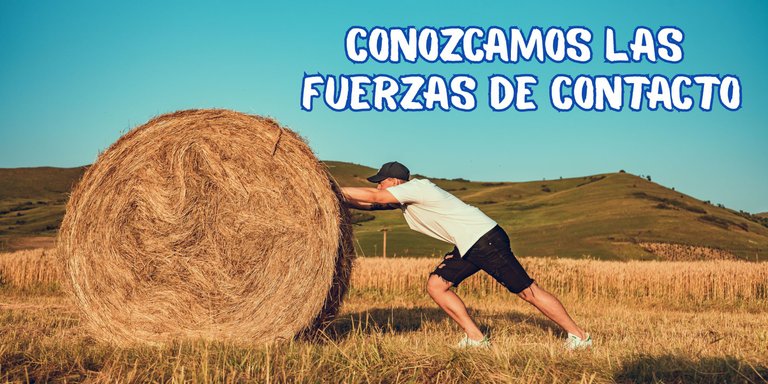
Imagen realizada con la página web de diseño gráfico y composición de imágenes Canva // Image made with the graphic design and image composition website Canva.
Si paseamos un poco por el concepto de interacciones, lograremos saber que según él diccionario de la Real Academia Española una interacción “es una acción que se ejerce recíprocamente entre dos o más objetos, personas, agentes, fuerzas, funciones, entre otras”. En el mundo de la física hay cuatro tipos de interacciones las cuales pudimos desarrollar en la publicación anterior. Ahora bien, aparte de las fuerzas a distancia también existen las fuerzas de contacto, las cuál es la fuerza que ejerce sobre dos objetos que se encuentran en contacto.
Por ejemplo, una pelota no se mueve sin ser pateada, un libro que está sobre una mesa no se abrirá solo a menos que una persona lo haga, un vaso de agua sobre nuestra mesa de noche permanecerá allí mientras dormimos. Según él concepto de fuerza propuesto por Isaac Newton dice que un objeto estaría en su posición, ya sea en reposo o en movimiento a menos que se aplique sobre el mismo una fuerza externa; si analizamos bien la definición de fuerza podemos resaltar que se trata de un estímulo que aplica sobre un objeto para que haga algo. Cabe destacar que la fuerza puede ser a favor del movimiento o en contra, también se puede decir que la fuerza está relacionada con la masa del objeto, mientras mayor sea la masa del mismo, mayor debe ser la fuerza que se le aplique al objeto.
If we take a walk through the concept of interactions, we will learn that according to the dictionary of the Royal Spanish Academy an interaction “is an action that is exerted reciprocally between two or more objects, persons, agents, forces, functions, among others”. In the world of physics there are four types of interactions which we were able to develop in the previous publication. Now, apart from the forces at a distance, there are also contact forces, which is the force exerted on two objects that are in contact.
For example, a ball does not move without being kicked, a book on a table will not open by itself unless a person does it, a glass of water on our night table will remain there while we sleep. According to the concept of force proposed by Isaac Newton says that an object would be in its position, either at rest or in motion unless an external force is applied on it; if we analyze well the definition of force we can highlight that it is a stimulus applied on an object to make it do something. It should be noted that the force can be in favor of the movement or against, it can also be said that the force is related to the mass of the object, the greater the mass of the object, the greater the force applied to the object.
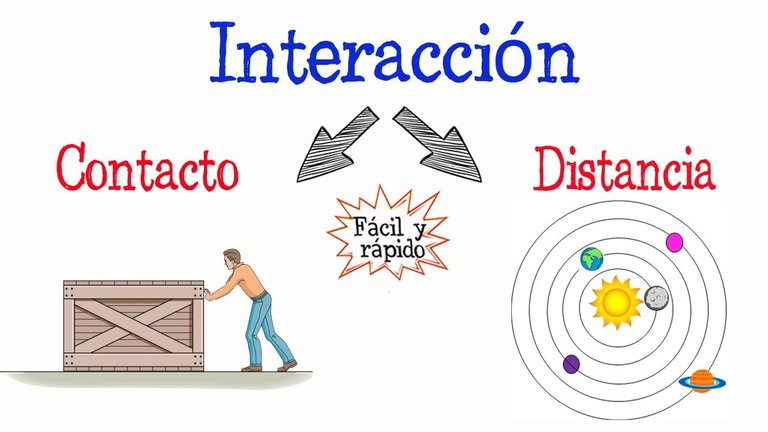
Source
Ahora bien, ya sabemos que las fuerzas pueden ser a distancia o contacto y en esta oportunidad nos enfocaremos en las de contacto, las cuales se refieren a aquellas que actúan solamente si existe contacto entre el cuerpo que ejerce el contacto y el que la recibe. Algunas fuerzas de contacto son la fuerza de fricción, la fuerza normal y la fuerza de tensión, el empuje y las fuerzas elásticas.
Comenzando con nuestra primera fuerza de contacto tenemos la fuerza de fricción o también conocidas como roce, se puede decir que es la fuerza presente entre dos superficies en contacto y que se opone al movimiento, es decir, tiene una dirección contraria al movimiento. No obstante, la fuerza de fricción puede ser estática que es cuando se opone al comienzo de un movimiento o también dinámica cuando se opone al movimiento relativo.
Now, we already know that forces can be at a distance or contact and in this opportunity we will focus on contact forces, which refer to those that act only if there is contact between the body that exerts the contact and the one that receives it. Some contact forces are friction force, normal force and tension force, thrust and elastic forces.
Starting with our first contact force we have the friction force or also known as friction, it can be said that it is the force present between two surfaces in contact and that opposes the movement, that is to say, it has a direction opposite to the movement. However, the friction force can be static, which is when it opposes the beginning of a movement, or dynamic when it opposes the relative movement.
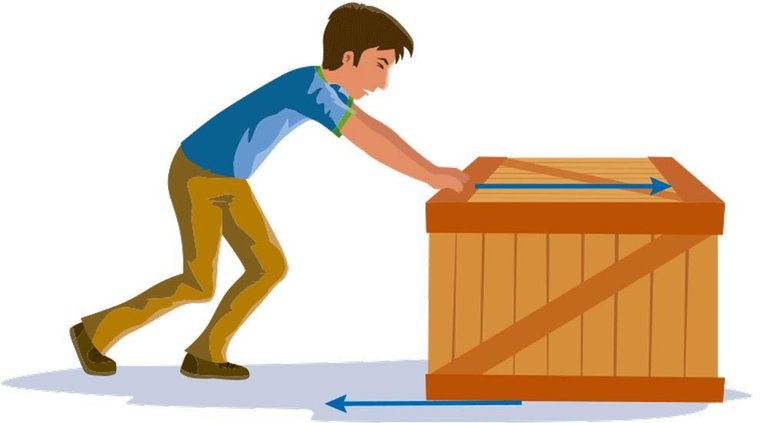
Source
La segunda de las fuerzas es la normal, se trata de aquella que es ejercida por una superficie sobre un cuerpo que se encuentra en reposo sobre ella. Esta fuerza tiene el sentido contrario, pero la misma dirección y magnitud que la fuerza que ejerce el propio cuerpo sobre la superficie en cuestión. Algunas de las características primordiales se encuentra que la fuerza normal es perpendicular a las superficies que están en contacto, también el contacto entre dos cuerpos implica otras fuerzas pero que son paralelas como por ejemplo la fricción.
The second force is the normal force, which is the force exerted by a surface on a body at rest on it. This force has the opposite direction, but the same direction and magnitude as the force exerted by the body itself on the surface in question. Some of the primary characteristics are that the normal force is perpendicular to the surfaces that are in contact, also the contact between two bodies involves other forces but that are parallel such as friction.
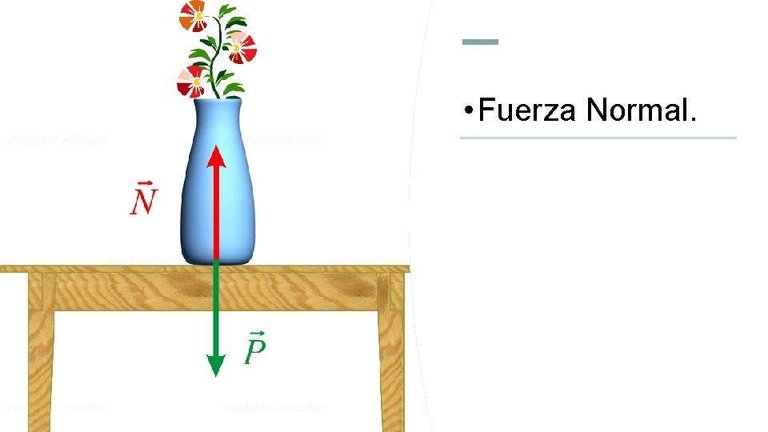
Source
La tercera es la fuerza de tensión, se trata de la fuerza que se ejerce para tirar una cuerda o cable que se encuentra tenso. Por ejemplo, las cuerdas permiten transmitir fuerzas de un cuerpo a otro, cuando en los extremos de la cuerda se aplican fuerzas iguales y contrarias la misma se pone tensa, por lo que cada una de estas fuerzas soporta la cuerda sin romperse.
The third is the tension force, which is the force exerted to pull a rope or cable under tension. For example, ropes allow the transmission of forces from one body to another, when equal and opposite forces are applied at the ends of the rope, the rope becomes taut, so that each of these forces supports the rope without breaking.

Source
Continuando con los tipos de fuerzas de contacto también se encuentra el empuje, el cual hace referencia a la fuerza que ejerce un fluido, es decir, un líquido o un gas, sobre un objeto sumergido en él. Dichas fuerzas actúan en sentido contrario a la gravedad, por lo que elevan el objeto. Él principio de Arquímedes explica perfectamente este fenómeno, ya que nos dice que “un cuerpo sumergido experimenta un empuje hacia arriba igual al peso del fluido que desplaza”.
Continuing with the types of contact forces, there is also thrust, which refers to the force exerted by a fluid, i.e. a liquid or gas, on an object immersed in it. Such forces act in the opposite direction to gravity, thus lifting the object. Archimedes' principle explains this phenomenon perfectly, since it tells us that “a submerged body experiences an upward thrust equal to the weight of the fluid it displaces”.
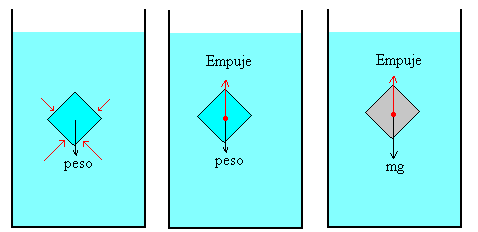
Source
Y por último, tenemos las fuerzas elásticas, la cual se podría decir que es una propiedad que tienen ciertos materiales de ser deformados bajo una fuerza externa que actúa sobre ellos. Suponiendo que tenemos un material elástico y que uno de los extremos se encuentra fijo, al otro extremo se le aplica una fuerza que probablemente lo deformará. Si dicha fuerza es tan grande que sobrepase su elasticidad, se puede deformar permanentemente, pero de no ser así se cumplirá la Ley de Hooke y cuando termine la fuerza el mismo volverá a su estado original.
And finally, we have elastic forces, which could be said to be a property that certain materials have of being deformed under an external force acting on them. Supposing that we have an elastic material and that one of the ends is fixed, a force is applied to the other end that will probably deform it. If the force is so great that it exceeds its elasticity, it can be permanently deformed, but otherwise Hooke's Law will be fulfilled and when the force is terminated it will return to its original state.
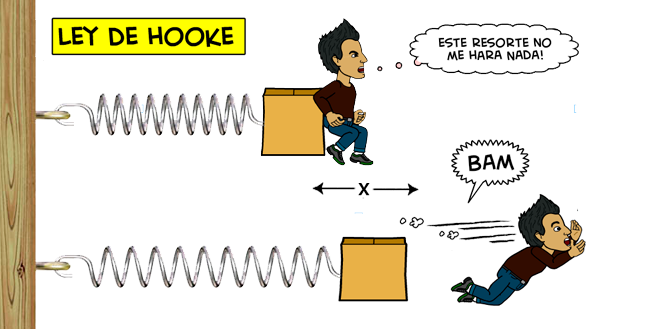
Source
Ya para despedirme espero que el tema sea del agrado de los lectores y deseo ver en los comentarios sus opiniones y aportes significativos que ayuden a la ampliación del tema y que genere un debate crítico y enriquecedor para la satisfactoria divulgación del conocimiento científico
In closing, I hope that the topic is to the readers' liking and I hope to see in the comments your opinions and significant contributions that will help to broaden the topic and generate a critical and enriching debate for the satisfactory dissemination of scientific knowledge.
Referencias
GIANCOLI, DOUGLAS. (2007). Física. Editorial: Pearson
Serway, R; Jewett J. (2005). Física para Ciencias e Ingeniería. Editorial Thomson: México.
Zemansky, S. (2009). Física Universitaria Volumen II. México: Pearson Educación.
References
GIANCOLI, DOUGLAS. (2007). Physics. Publisher: Pearson
Serway, R; Jewett J. (2005). Physics for Science and Engineering. Editorial Thomson: México.
Zemansky, S. (2009). Physics Volume II. Mexico: Pearson Educación.
Translator Deepl


Posted Using INLEO
https://x.com/ILovePhysica/status/1938029969839468557?t=Dlyfg25bpU2sX47kxmNnFQ&s=19
Thanks for your contribution to the STEMsocial community. Feel free to join us on discord to get to know the rest of us!
Please consider delegating to the @stemsocial account (85% of the curation rewards are returned).
Consider setting @stemsocial as a beneficiary of this post's rewards if you would like to support the community and contribute to its mission of promoting science and education on Hive.